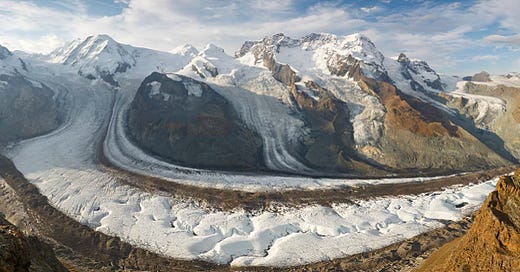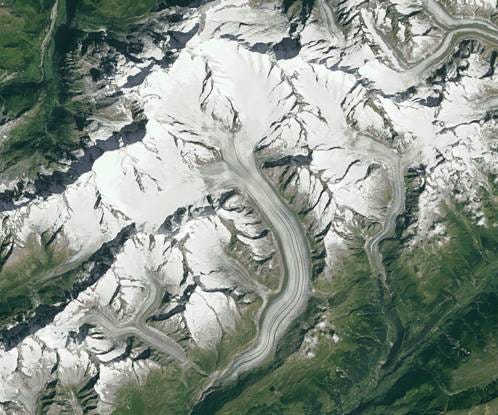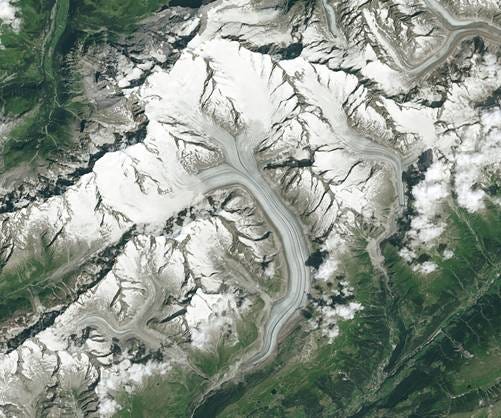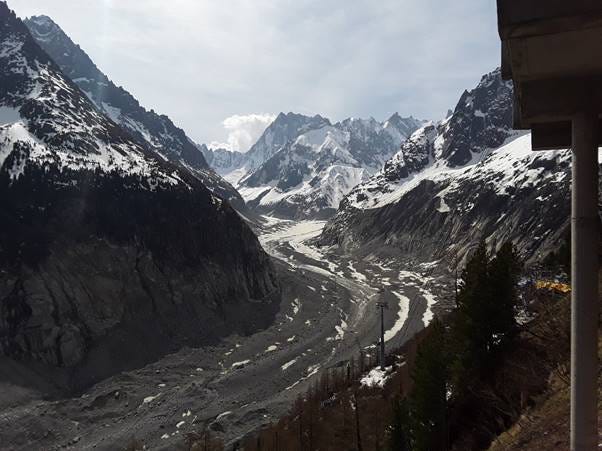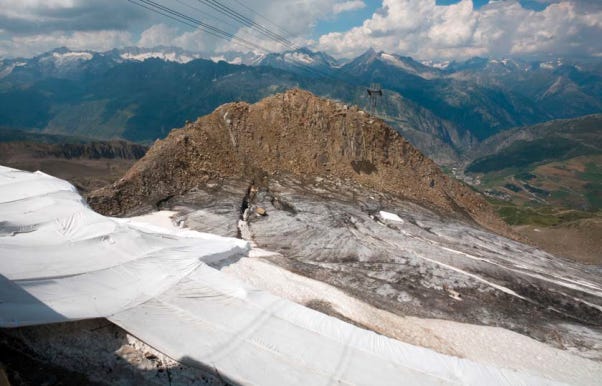[A bit of a topsy-turvy week in terms of subscribers. Several have joined having come via Geoff Gibson’s Substack recommendation - is it a fair assumption to say they are based in North America?; several have left – I reckon these are A Level students who have now done their exams and no longer need/want this Substack. I hope the latter found my musings useful, and that they see success in their results in August.
The following post was planned before the events in Switzerland this week, as detailed below…
On Wednesday 28th 2025, at 3.30pm local time, a catastrophic glacier collapse buried a large amount of the village of Blatten in the Swiss Alps. A massive rockfall from the Kleines Nesthorn peak triggered a collapse of the Birchgletscher (Birch glacier). The rockfall deposited over 9 million tonnes of debris on to the glacier, speeding up the movement of the glacier. The glacier collapsed sending a massive flow of ice, mud and rock into the Lotschental valley. Blatten’s 300 residents had been evacuated earlier in May as the collapse had been anticipated. One person is missing. The landslide has blocked the Lonza river raising concerns of potential flooding of villages further down the valley. There are obvious concerns that these events have been made worse and more likely by climate change.
The following links provide some photographic and video evidence of the event:
Photos before/after: here.
And an excellent storybook by the BBC here.
Now, to the post…]
The Alps extend across more than 1,000km across eight European countries. The area is the location of thousands of glaciers, including the largest - the Great Aletsch Glacier (Grosser Aletschgletcher) in southwestern Switzerland. However, like many glaciers in the Alps, the Aletsch is retreating and thinning.
The following two images (from NASA) illustrate the changes in the Aletsch (the middle glacier) across the past 40 years. The first image was taken in September 1984, and the second image in August 2024. Changes to the length and width of the glaciers are clearly visible. The shortening and narrowing of a glacier’s surface area indicate a net loss of ice mass. According to the Swiss Glacier Monitoring Network (GLAMOS), Aletsch has retreated more than 1,300m since 1984. It has also thinned, contributing to the glacier’s narrower appearance in the 2024 photo. You can investigate the shrinking of this glacier (and other Swiss glaciers) on the GLAMOS website here.
Aletsch’s neighbours also show decline, albeit more subtly. Since 1984, Oberaletsch Glacier (to the left) has retreated more than 240m, and Fiescher Glacier (to the right) has retreated more than 1,000m.
The images follow a particularly warm summer in 2024 that melted the snowfall from the previous winter; Swiss glaciers last year lost 2.5% of their volume. The warming climate is strongly affecting Switzerland's glaciers, which lost 10% of their volume to melting in 2022 and 2023 - the same amount lost over three decades from 1960 to 1990.
1984
2024
[In 2023, I took this photo of the Mer de Glace glacier near Chamonix, France. Clear evidence of the impact of climate change, I would suggest? There is ice under the dark and thick layer of moraine, but its thickness is much depleted. I found it heartbreaking to observe.]
Photo: David Redfern
The economic consequences
Up to half of all Switzerland’s ski resorts could face economic hardship or bankruptcy because of climate change. Climate scientists have repeatedly warned that because of rising greenhouse gas emissions, global temperatures could rise by more than 4°C by 2100. Glaciers in Switzerland are predicted to recede at an accelerated rate. Such a process will lead to a massive change in the landscape with changes in the water balance, and more glacial lake outbursts, mudslides and debris slides.
Of Switzerland’s 230 ski resorts, only 85% are now classified as ‘snow reliable’ and these are in areas where the snowline is above 1200m. In the next 50 years, snow in these regions could become unreliable at altitudes of 1500m or more. The number of snow reliable ski resorts is predicted to drop to 60%. The Jura, eastern and central Switzerland, Ticino and the Alpine cantons of Vaud and Fribourg will be particularly at risk. However, in one scenario the snowline could rise to 1800m, which would mean that one resort in four, even in the highest cantons of Grisons and Valais, could face ruin.
The future of European ski resorts
Shardul Agrawala, author of Climate Change in the European Alps, predicts the disappearance of 75% of Alpine glaciers within 45 years, a surge in avalanches and floods and the closure of all but the highest ski resorts. In the Alps, recent climate warming has advanced at three times the average world rate. Agrawala claims that within 20 years, ski resorts below 1050m will no longer be viable. In 100 years’ time, he expects only the highest resorts will be able to offer reasonable guarantees of snow.
Climate change will have the effect of pushing more and more winter sports higher and higher up mountains, concentrating impacts in ever decreasing, high-altitude areas. As ski resorts in lower altitudes face bankruptcy, so the pressure on highly environmentally sensitive, upper-altitude areas rises along with the pressures to build new ski lifts and other infrastructure. Warmer temperatures will make artificial snowmaking increasingly inefficient and expensive, if not impossible. Moreover, plastic sheeting could protect glaciers but will not prevent the eventual loss of glaciers if warming trends continue.
Rising temperatures will also have other economic and safety impacts. Permafrost is likely to be more vulnerable to melting, increasing the risks of landslides and raising the costs associated with anchoring and bracing cable car stations, lift masts and other structures. Avalanches may become more common above 2000m, which may increase risks to skiers and other sports people as well as damage to infrastructure.
Some experts have suggested that tourism losses in Switzerland, due to climate change, could eventually be as high as $1.2 to $1.6 billion annually.
Artificial snow
Man-made snow is used on about 10% of Switzerland’s slopes. The proportion of pistes with cannons available is now five times the level in 1990. However, the manufacture of artificial snow is costly in terms of energy and quantities of water required. More worrying is the natural erosion caused by the increase in meltwater which runs back down the mountain in the spring. There is also a suggestion that chemical additives used in the production of artificial snow affect the natural vegetation. As meltwater comes off the slopes, chemicals used in this production of snow potentially find their way into rivers that supply drinking water.
Covering glaciers with blankets
A novel approach to protecting the ski industry has occurred on the Gurschen Glacier at the top of the Andermatt ski resort. Having lost 20m of ice thickness since 1990 and to prevent further melting, the Andermatt ski-lift company laid a synthetic carpet over 2500 square metres of glacier in an experiment to ward off the effects of warming. The reflective high-tech material is designed to stop the Gurschen Glacier from melting away beneath the resort’s upper cable-car station. (See photo below)
Environmental organisations have criticised the move as being ineffective. Nevertheless, if it proves successful, many other ski resorts which also depend on rapidly shrinking glaciers, including Zermatt, Saas Fee and Engelberg, could follow Andermatt’s example. The material’s resistance to ultraviolet rays gives it a lifespan of at least 10 years.
Conclusion
The retreat of Swiss glaciers has environmental and economic consequences. The nature of winter sports tourism is changing. Climate change appears to be forcing skiers to higher altitudes. This could have a devastating effect on the economy of lower resorts. In addition, the environmental impacts of skiing are far reaching – pollution, erosion, avalanches and landslides, and impacts on biodiversity. If skiing is to be concentrated in fewer, higher resorts, the negative effects are likely to be magnified.

